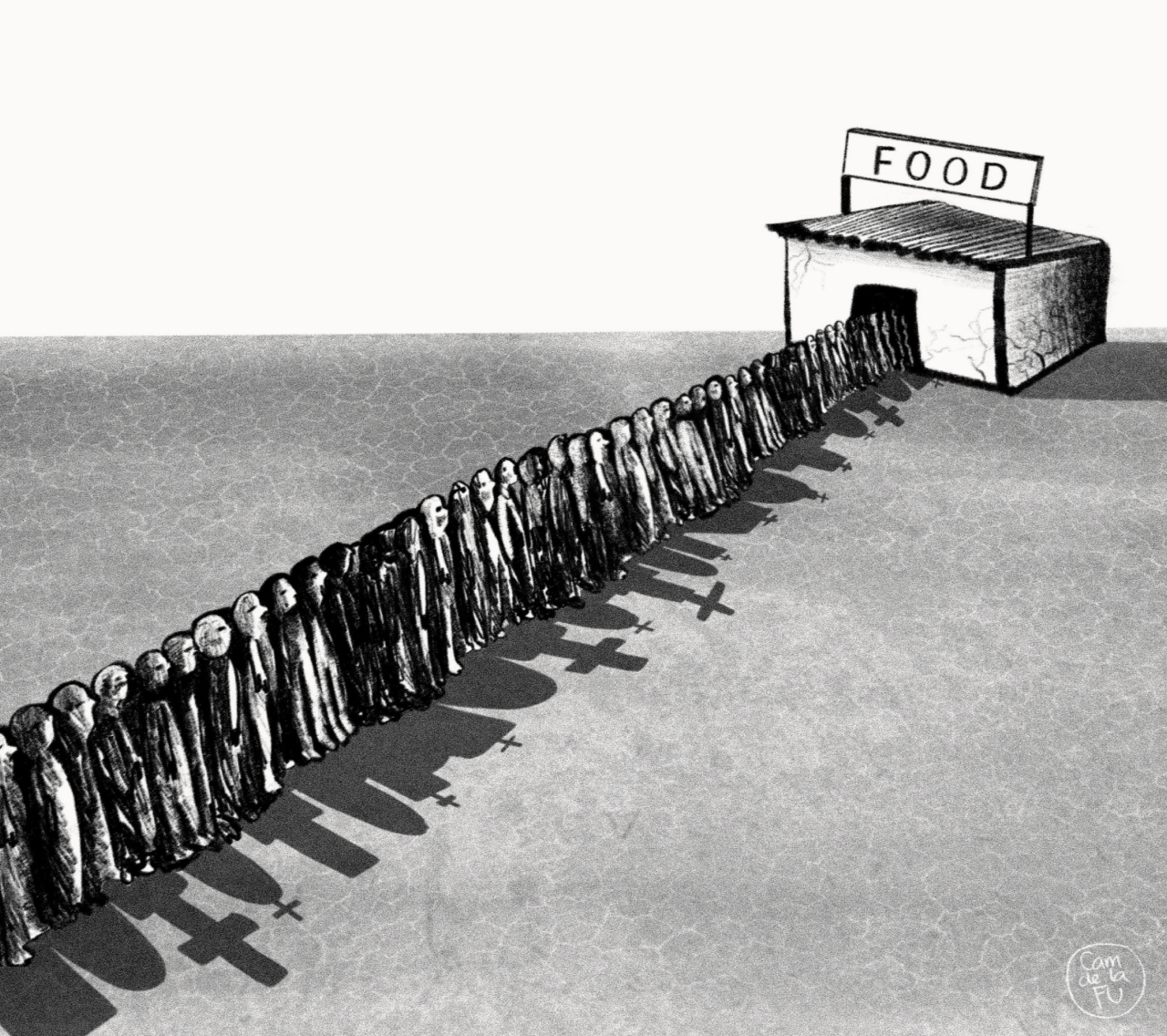This is part 1 of our blog series on Alex de Waal’s “Commemorating Starvation in the 21st Century: Address given at Quinnipiac University on October 11, 2018.” The full essay is also available as a pdf.
The first American memorial to the 1845-51 famine in Ireland, was designed by the sculptor Maurice Harron and erected on Cambridge Common in 1997. It shows two adults, each holding a child, parting from one another. The plinth has the words ‘Never again should a people starve in a world of plenty.’
Notice the importance of that indefinite article: ‘a people’.
On that word, hinges much. It signals famine as a collective, national experience, as opposed to hunger as a generic manifestation of poverty. In doing so it also identifies the community that has the authority to narrate its meaning today—a community brought together by common descent from the survivors of that famine.
The figures also indicate the importance of migration and parting—linking the experience of the Irish in Ireland, to the Irish in New England.
It intimates that the famine should be seen as a wrong inflicted, not just a wrong suffered. But the notion that the Irish not only starved, but that they were starved by others, is at best a faint suggestion, and one easily missed.
Memorials and commemorations identify an event, those who are affected by it and—by the process whereby they are designed and built—those who are entitled to define it. They open up the scope for reshaping the meaning of the event and its memory, for the future.
In this lecture, my main contention is that famine memorials have, up to now, focused on starvation in its intransitive sense—as an outcome or an experience. They have not explored how to commemorate starvation in its transitive sense, as something that people do to one another. A memorial or commemoration that tried to evoke starvation as an act—a criminal act no less—would of necessity relate not only to the victims and survivors, but also to the perpetrators, their accomplices, and bystanders. This is a demanding but necessary shift in purpose today, because famine is returning.
—
In a little known lecture on Soviet policy in Ukraine, given in 1951, Rafael Lemkin wrote of genocide in that nation. Stalin’s purges, terror, forced collectivization and mass starvation inflicted during 1932-34 are, he wrote, not simply a case of mass murder. It is a case of genocide, of destruction, not of individuals only, but of a culture and a nation.
Scholars of genocide and international human rights and humanitarian law tend to read intellectual history backwards and legalistically. Lemkin was the Polish lawyer, author of Axis Rule in Occupied Europe, who coined the term ‘genocide’ and campaigned tirelessly for it to be recognized as a crime under international law, and prohibited. He used the raw and recent memory to forge an international agenda of law and meaning.
The 1948 Genocide Convention was indeed the culmination of Lemkin’s life’s work, albeit with some important shortcomings that he bemoaned. But there is another perspective that is worth exploring.
Lemkin was a romantic nationalist. It is today regarded as a somewhat quaint political philosophy, which essentialises culture and collective identity. Lemkin’s notion shares a genealogy with those same concepts of race, against which he fought, which brought Europe to the brink of destruction. However, in Lemkin’s writing, the concepts of race, nation and culture are egalitarian. He saw all nations as having equal rights to exist; he challenged any hierarchy according to which one nation might be entitled to dominate another. Thus in his writing on genocide, he defined it first sociologically, seeking to derive a legal formulation from that. Lemkin saw genocide as a two-stage process, first of all the destruction of the national pattern of the targeted national group, and second the imposition of that of the perpetrator. The colonial conquest and subjugation of the emergent third world, Lemkin argued, contained paradigmatic cases of genocide.
In the case of Ukraine in the early 1930s, Lemkin argued that Stalin’s plan, had four prongs:
- Elimination of the intelligentsia: the brain of the nation;
- Elimination of the religious leadership: the soul of the nation;
- Starvation of the masses, and with it elimination of the national spirit;
- Fragmentation and dispersion of the Ukrainian people.
Let me quote what Lemkin had to say about famine:
The third prong of the Soviet plan was aimed at the farmers, the large mass of independent peasants who are the repository of the tradition, folklore and music, the national language and literature, the national spirit, of Ukraine. The weapon used against this body is perhaps the most terrible of all—starvation.
The Holodomor has since become an element in the country’s self-definition. But I want to focus on three insights, that are implicit the notion of famine as an assault on the collective spirit. Each needs to be elaborated.
—
The first insight is that starvation is properly seen as an act, not an outcome. In cases such as Ukraine, the verb ‘to starve’ is properly seen as transitive: like torture or rape, it is something that people do to one another. Lemkin wrote extensively on the topic of the deprivation and rationing of food as a means of punishment or slow killing. If we read his seminal book Axis Rule, we find that far more detail is expended on providing details of the reduced rations allocated to conquered populations, than on killing squads and gas chambers.
Indeed the Nazis’ single biggest project of mass killing was the Hungerplan: the elimination of 30 million people in eastern Europe and the Soviet Union by depriving them of food. It was not, fortunately, carried through to completion, but nonetheless the Nazis murdered about 2.5 million Soviet prisoners of war by this method, along with the siege of Leningrad, which killed 1 million, and the starvation of Ukrainian and southern Russian cities which killed a comparable number, the deaths of 80,000 from hunger in the Warsaw Ghetto, and the starvation deaths of perhaps half a million in Auschwitz. Forcible mass starvation is difficult to achieve expeditiously and at scale, and when the quotas for the elimination of so-called ‘useless eaters’ proved difficult to reach, the Nazis turned to quicker methods.
Had the Nazis persisted, however, one outcome might well be that the Hungerplan would have become the signal atrocity of the 20th century, dominating our collective imaginations, and mass starvation would have been criminalized.
Starvation had utility for the Nazis. As indeed it had for colonizers before and since. Acts of colonial conquest, subjugation and extraction had created famine, from the East India Company in Bengal in the 1770s through the American settlers’ use of hunger to expropriate Native American lands, through the British concentration camps in South Africa. The 1863 Lieber Code that regulated the conduct of the Union armies during the Civil War infamously provided that ‘it is lawful to starve the hostile belligerent, armed or unarmed, so that it leads to the speedier subjection of the enemy.’ In his 1906 Handbook for Small Wars, Colonel Sir Charles Callwell advised his fellow officers that pacification operations would likely involve confiscating cattle and burning villages, ‘an aspect that may shock the humanitarian.’
The locus classicus of colonial genocide by starvation is the German eradication of the Herero in south-west Africa in 1904. In response to an uprising against imperial rule, the German military commander ordered that the Herero people in their entirety be driven into the desert, where about 40,000 died of hunger and thirst.
A small stone in the desert marks this crime.
The maritime powers that prevailed over the Axis in 1945 had their honed their practices of using starvation in war. The British infamously cranked up the blockade of Germany following the Armistice of 1918, with the intent of forcing the defeated country to submit to the onerous terms of the Peace of Versailles, costing many scores of thousands of lives of German children. The raw and recent memory of that suffering and its consequences encouraged Germans—most infamously Adolf Hitler—to see national food security through the possession of agricultural land as a precondition for prevailing in any future war.
In 1941 the Allied blockade of Greece caused a famine. And in July and August 1945, as the Nuremberg Charter for the prosecution of leading Nazis for war crimes, crimes against humanity, and crimes against peace, was being drafted, and the United States was preparing for a protracted war against Japan, the USAAF was dropping mines into Japanese harbours to inhibit any sort of trade in an operation they candidly called ‘Operation Starvation.’
We should not be surprised that starvation crimes barely made it to the charge sheet in Nuremberg.
Subsequently, colonial counter-insurgency, intended to keep colonial territories under metropolitan rule, could serve as a handbook for how to create a famine. Lt. Gen. Sir Harold Briggs, Director of Operations for the British in Malaya in 1951, used the term ‘Operation Starvation’ for his project of denying food to the Communist guerrillas. In 1964, Colonel Roger Trinquier, advisor to the French war efforts in Vietnam and Algeria, wrote that it was necessary to ‘make the ground unsuitable’ for the guerrilla:
Anything that could facilitate the existence of the guerillas in any way, or which could conceivably be used by them – depots, shelters, caches, food crops, houses, etc. – must be systematically destroyed or brought in. All inhabitants and livestock must be evacuated from the [guerrillas’] refuge area. When they leave, the intervention troops must not only have destroyed the [guerrilla] bands, but must leave behind them an area empty of all resources and absolutely uninhabitable.
Contemporary counter-insurgency may not be so different.


